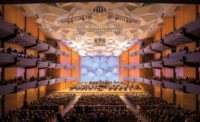From the street, the seven-story building by Toronto’s architectsAlliance is difficult to figure out. A set of three volumes wrapped in curtain wall and dark gray brick, it could be offices or apartments. According to partner-in-charge John van Nostrand, this smooth, contemporary wrapper contains something quite familiar. “Essentially,” he says, “it’s an old-time hotel.”
In fact, Evangel Hall consists of a thoughtful hybrid of a single-room-occupancy (SRO) residence and social-service hub, but designed with plenty of care and the graciousness of a Victorian hotel. Located in a mixed-use neighborhood in downtown Toronto, Evangel Hall, an inner-city mission of the Presbyterian Church of Canada, includes 84 units of transitional housing. It also serves as home to a church drop-in center that caters to the city’s homeless with a cafeteria and an array of social services.
In development for more than a decade, Evangel Hall’s new 57,000-square-foot building speaks decisively to the debate in low-income housing between congregate living, in which people share apartments, and hotel-style facilities with self-contained residences. For van Nostrand, a strong moral dimension underlies this debate. Having designed low-income housing projects over the past 25 years, and studied their Modernist predecessors—from work by Le Corbusier and Mart Stam through New York’s Common Ground SROs and Arthur Erikson’s Portland Hotel in Vancouver—he concluded that congregate housing “pits architectural theory about what we think people want against the facts—that people want to have their own space.”
Van Nostrand and his team, including project architect Paul Kulig, recommended the hotel model to their clients, despite the fact that it has been out of favor, especially in Canada. “It was a huge missing block in the housing spectrum,” he says. The client, Evangel Hall Mission, which had previously operated a downtown soup kitchen and a drop-in center but never a residence, was convinced that an SRO was the best solution because of the density that could be achieved. So architectsAlliance designed a scheme with mostly 225-square-foot studio apartments. Such small units, while accepted in the U.S., were controversial in Canada and illegal under existing building codes. After an extensive study of the issue, including focus groups with possible residents, van Nostrand and his team succeeded in lobbying the government to change the rules.
To serve both the residents and the client, the architects made flexibility an important theme in their design. They created a building that looks like (and can work as) two attached facilities: a long, six-story block, wrapped in a curtain wall that combines transparent and opaque glass in a lively checkerboard pattern, and a smaller, seven-story structure clad in gray brick. A lobby near the middle of the long block serves the drop-in center, with its cafeteria, thrift shop, and a range of other social services located on the main floor and in the basement. A second lobby, in a narrow glass wedge extending from the south end of the building, provides access to elevators taking residents to the apartments upstairs. This arrangement allows the residents access to the public facilities downstairs while giving them privacy from visitors to the drop-in center. Yet only a door separates the two sections. If the building were reconfigured, the two wings could be easily combined. Likewise, the architects deliberately made the public areas on the first floor and in the basement generic in character, so they could evolve and serve different functions over time. “The idea was to create large spaces with niches and character that can be transformed,” van Nostrand said. In fact, a street-front space that opened as a thrift shop later became home to Evangel Hall’s youth drop-in center. The thrift shop, meanwhile, moved to the basement.
Since the building’s poured-concrete structure has few columns, the residences have flexible floor plans. Knockout panels built into partitions between apartments can be easily removed, so neighboring units can be combined. Two of the basic 225-square-foot studios with a shower can be combined to create a one-bedroom apartment, or three of them can create a two-bedroom unit. Van Nostrand compares the openings between rooms to suite doors in a hotel, but notes that the apartments in their current state are truly separate, letting residents remain self-sufficient.
When it came to the facade, “The idea was to make it look like a market-rate building,” van Nostrand says. So the exterior brick and the curtain wall, with its syncopated design of colored spandrels, look similar to what the architect has used on high-end condominium and university projects. The checkerboard elevation camouflages the socioeconomic conditions of the people living inside, giving them the same consideration as people living in more expensive housing. And it sends a message: that quality design can be made available to everybody.






Post a comment to this article
Report Abusive Comment